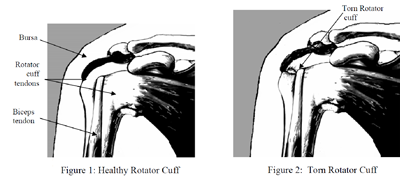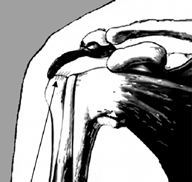Rotator cuff patient education
What is the Rotator Cuff?
The rotator cuff consists of four small muscles that originate on the scapula (shoulder blade) and attach with tendons around the head of the humerus (upper arm bone). These four muscles form a “cuff” that keeps the ball shaped head of the humerus seated in the shallow socket of the scapula (Figure 1). The tendon is the most common site of rotator cuff tear and may involve one or more of the four tendons (Figure 2)
What is Rotator cuff Repair?
In Rotator Cuff Repair surgery, the torn muscle tendon(s) are reattached back onto the humerus to improve shoulder function and reduce shoulder pain.
How is Rotator Cuff Repair surgery performed?
Metal or absorbable screws are inserted into thr humerus. These screws have sutures attached to the top that are threaded through the torn portion of the rotator cuff tendon, and pulled tight to anchor the tendon down onto the humerus. This procedure is performed through an arthroscope, or through a small incision
What can I expect after surgery?
Pain Management
- Medication
- Ice
- Rest/Sleep
The arm receiving surgery will be numb for 6-12 hours after surgery due to receiving a nerve block. When the nerve block wears off, shoulder pain is expected. In order to minimize pain, pain medication and anti-inflammatory medication should be taken as prescribed. Staying ahead of pain with the use of the prescribed medication will make it easier to manage.
Use the ice machine unit or the ice gel pack continuously for the first several days after surgery to help with pain control and to minimize swelling in the area of the surgery. This unit will require a large amount of ice, so it is advisable to purchase or make extra ice prior to surgery. Regular use of ice is associated with less pain and lower use of prescription pain medication after surgery. Continue to ice the shoulder for 20-30 minutes after exercise sessions, or any time there is an increase in pain.
It is often difficult to assume a comfortable resting position after rotator cuff repair surgery. It is recommended to place a pillow behind the upper arm to keep the arm from dropping back, and to sleep sitting propped up in bed or in a recliner during the first month after surgery.
General Guidelines for Functional Recovery
- Sling immobilization
- Dressing/grooming
- Activity Guidelines
- Driving – not recommended while taking pain medication
- Return to driving should be discussed with physician
- Computer/desk work – 1-2 weeks after surgery with sling on
- It is advisable to use a lap tray for keyboarding, with a wrist rest and mouse attachment, so that work can be performed with arms down and sling on for the first 4-6 weeks following surgery.
- A head set or ear piece is recommended when using the telephone.
- Light weight active work below shoulder level – 6-8 weeks
- Strengthening with resistance – 3 months
- Golf, fishing – 4-5 months
- Racquet or throwing sports or heavier overhead use – after 6 months
The arm will be immobilized in a sling for 4-6 weeks from the date of surgery. It is very important that the sling be worn at all times, except for during prescribed exercises, and basic grooming. The sling should even be worn during sleep. Due to the immobilization and immediate post-operative discomfort, it is often helpful to plan to have assistance for the first several days following surgery.
It is advisable to wear shirts that button up the front during the initial recovery period, and to put the operated arm into the shirt sleeve first, followed by the non-operative arm. The sling may be removed while showering, with care taken to have the arm hang passively while washing.
These guidelines may vary depending on healing, size of tear, and progress in rehabilitation. Activity is extremely limited during the first 4 weeks after surgery, even when there is little or no pain.
Rehabilitation
Physical therapy begins after your 1st follow-up appointment 7-10 days after surgery, with appointments 1-2 times per week and home exercises prescribed that should be done several times per day. Therapy is divided into three phases:
- Phase 1: Initial 4-6 weeks after surgery:
- The goals during this time frame are to protect repaired rotator cuff tendons, minimize pain, and prevent post-operative stiffness with passive range of motion exercises. Aquatic therapy may be initiated around 3 weeks after surgery. Sling use is discontinued at the end of this phase.
- Phase 2: 6-12 weeks after surgery:
- The goal during this phase of rehabilitation is to restore full motion to the operative shoulder, both passively and actively, with normal movement patterns.
- Phase 3: 3-6 months after surgery:
- The goal of this phase of rehabilitation is to restore normal strength and function to the operative shoulder. This goal is achieved with gradually progressed resistive exercise. Therapists also assess sports and work goals and help to develop functional progressions toward achieving these goals.









